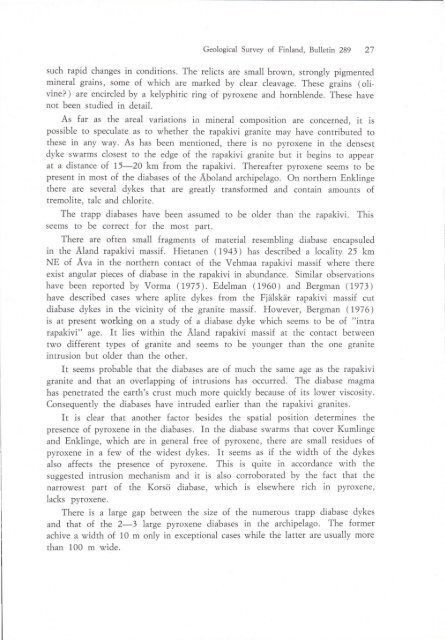Geological Survey of Finland Bulletin 289 - arkisto.gsf.fi
Geological Survey of Finland Bulletin 289 - arkisto.gsf.fi
Geological Survey of Finland Bulletin 289 - arkisto.gsf.fi
Create successful ePaper yourself
Turn your PDF publications into a flip-book with our unique Google optimized e-Paper software.
<strong>Geological</strong> <strong>Survey</strong> <strong>of</strong> <strong>Finland</strong>, <strong>Bulletin</strong> <strong>289</strong> 27<br />
such rapid changes in conditions. The relicts are small brown, strongly pigmented<br />
mineral grains, some <strong>of</strong> which are marked by dear deavage. These grains (olivine?)<br />
are encirded by a kelyphitic ring <strong>of</strong> pyroxene and hornblende. These have<br />
not been studied in detail.<br />
As far as the areal variations in mineral composition are concerned, it lS<br />
possible to speculate as to whether the rapakivi granite may have contributed to<br />
these in any way. As has been mentioned, there is no pyroxene in the densest<br />
dyke swarms dosest to the edge <strong>of</strong> the rapakivi granite but it begins to appear<br />
at a distance <strong>of</strong> 15-20 km from the rapakivi. Thereafter pyroxene seems to be<br />
present in most <strong>of</strong> the diabases <strong>of</strong> the Aboland archipelago. On northern Enklinge<br />
there are several dykes that are greatly transformed and contain amounts <strong>of</strong><br />
tremolite, tale and chlorite.<br />
The trapp diabases have been assumed to be older than the rapakivi. This<br />
seems vo be correct for the most part.<br />
There are <strong>of</strong>ten small fragments <strong>of</strong> material resembling diabase encapsuled<br />
in the Aland rapakivi massif. Hietanen (1943) has described a locality 25 km<br />
NE <strong>of</strong> Ava in the northern contact <strong>of</strong> the Vehmaa rapakivi massif where there<br />
exist angular pieces <strong>of</strong> diabase in the rapakivi in abundance. Similar observations<br />
have been reported by Vorma (1975 ) . Edelman (1960) and Bergman (1973 )<br />
have described cases where aplite dykes from the Fjälskär rapakivi massif cut<br />
diabase dykes in the vicinity <strong>of</strong> the granite massif. However, Bergman (1976 )<br />
is at present working on a study <strong>of</strong> a diabase dyke which seems to be <strong>of</strong> "intra<br />
rapakivi" age . It lies within the Aland rapakivi massif at the contact between<br />
two different types <strong>of</strong> granite and seems to be younger than the one granite<br />
intrusion but older than the other.<br />
It seems probable that the diabases are <strong>of</strong> much the same age as the rapakivi<br />
granite and that an overlapping <strong>of</strong> intrusions has occurred. The diabase magma<br />
has penetrated the earth's crust much more quickly because <strong>of</strong> its lower viscosity.<br />
Gonsequently the diabases have intruded earlier than the rapakivi granites.<br />
It is dear that another factor besides the spatial position determines the<br />
presence <strong>of</strong> pyroxene in the diabases. In the diabase swarms that cover Kumlinge<br />
and Enklinge, which are in general free <strong>of</strong> pyroxene, there are small residues <strong>of</strong><br />
pyroxene in a few <strong>of</strong> the widest dykes. It seems as if the width <strong>of</strong> the dykes<br />
also affects the presence <strong>of</strong> pyroxene. This is quite in accordance with the<br />
suggested intrusion mechanism and it is also corroborated by the fact that the<br />
narrowest part <strong>of</strong> the Korsö diabase, which is elsewhere rich in pyroxene,<br />
lacks pyroxene.<br />
There is a large gap between the size <strong>of</strong> the numerous trapp diabase dykes<br />
and that <strong>of</strong> the 2-3 large pyroxene diabases in the archipelago. The former<br />
achive a width <strong>of</strong> 10 m only in exceptional cases while the latter are usually more<br />
than 100 m wide.

















